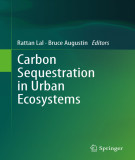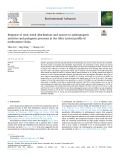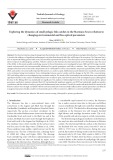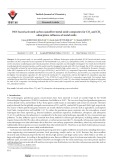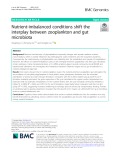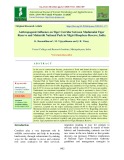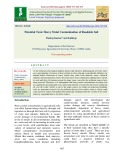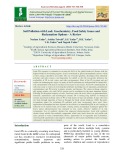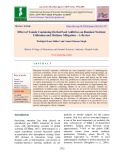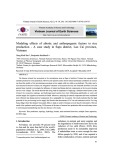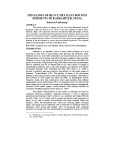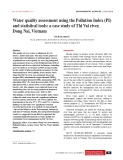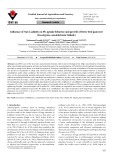
Anthropogenic influence
-
In ebook "Carbon sequestration in urban ecosystems" Urbanization drastically alters the ecosystems structure and functions, disrupts cycling of C and other elements along with water. It alters the energy balance and influences climate at local, regional and global scales. Judicious planning and effective management can enhance C pool in urban ecosystems, and off-set some of the anthropogenic emissions. Principal components with regards to C sequestration include home lawns and turfs, urban forests, green roofs, park and recreational/sports facilities and urban agriculture.
 383p
383p  tachieuhoa
tachieuhoa
 28-01-2024
28-01-2024
 6
6
 2
2
 Download
Download
-
The results showed that SOM content was higher in horizon A, whereas mineral matrix elements Al, Fe, and Mg contents were higher in horizon B. Ca and P contents gradually decreased with soil depth due to the influence of fertilizer. Three types of trace element concentration profiles were identified: (1) decrease with depth for Cd and Hg
 7p
7p  thebadguys
thebadguys
 15-01-2022
15-01-2022
 7
7
 0
0
 Download
Download
-
The geochemical behavior of Pb in terrestrial and coastal water systems significantly influences Pb biogeochemical cycling and pollutant exchange at the land-sea continuum. An ideal case study of Pb environmental geochemistry is Galveston Bay, an anthropogenic estuary exposed to industrial runoff, wastewater and shipping vessel spills but also fed by natural rivers.
 10p
10p  thebadguys
thebadguys
 15-01-2022
15-01-2022
 13
13
 0
0
 Download
Download
-
Maintaining landscape connectivity through identifying movement corridors is the most recommended conservation strategy to reduce the negative impacts of habitat loss and isolation. The basis of most connectivity modelling approaches for modelling corridors is that species choose movement pathways based on the same criteria they used to choose habitats. However, species behave differently in using landscape elements for moving than for selecting habitat. In other words, suitability of a given landscape feature may differ between moving and habitat use stages.
 12p
12p  dolomite36
dolomite36
 30-12-2021
30-12-2021
 14
14
 0
0
 Download
Download
-
The Marmara Sea has a large drainage basin that includes cities with heavy industrialisation and agricultural land use. Therefore, it is under the influence of significant anthropogenic activities that adversely affect the well-being of its ecosystem. The Marmara Sea is also an important fishing ground with many commercially important fish species. These fish species are also under the influence of the adverse impacts of anthropogenic activities. Fisheries catches in the Marmara Sea had experienced severe fluctuations since the onset of the 2000s.
 9p
9p  dolomite36
dolomite36
 30-12-2021
30-12-2021
 9
9
 0
0
 Download
Download
-
In the present study, we successfully prepared two different electrospun polyacrylonitrile (PAN) based-activated carbon nanofiber (ACNF) composites by incorporation of well-distributed Fe2O3 and Co3O4 nanoparticles (NPs). The influence of metal oxide on the structural, morphological, and textural properties of final composites was thoroughly investigated. The results showed that the morphological and textural properties could be easily tuned by changing the metal oxide NPs.
 13p
13p  tudichquannguyet
tudichquannguyet
 29-11-2021
29-11-2021
 6
6
 1
1
 Download
Download
-
Nutrient stoichiometry of phytoplankton frequently changes with aquatic ambient nutrient concentrations, which is mainly influenced by anthropogenic water treatment and the ecosystem dynamics.
 18p
18p  vilichoo2711
vilichoo2711
 25-06-2021
25-06-2021
 19
19
 1
1
 Download
Download
-
In the era of conservation forestry, protection of floral and faunal diversity is important prerequisite. Due to the effective implementation of conservation strategies in the protected areas, growth of faunal population will be in increasing phase which leads to the expansion of home range and territory. The present investigation was conducted to assess the human influence on the corridor between Mudumalai Tiger Reserve and Mukurthi National Park in Tamil Nadu during the period from August 2014 to July 2015.T
 6p
6p  chauchaungayxua11
chauchaungayxua11
 23-03-2021
23-03-2021
 8
8
 2
2
 Download
Download
-
Nitrogen is the key nutrient factor that influences soil fertility and productivity. It is the mineral nutrient that exists in different forms, but nitrate form is the most preferred form by plants. Irrespective of the form in which N is applied to soil, it undergoes transformation viz. mineralization (ammonification, nitrification), denitrification etc. by enzymes produced by micro organisms.
 17p
17p  trinhthamhodang7
trinhthamhodang7
 31-08-2020
31-08-2020
 25
25
 1
1
 Download
Download
-
Earthworm diversity and distribution patterns are generally governed by a variety of biotic and abiotic factors such as soil properties, surface litter, vegetation type and, land use pattern, local or regional climate and anthropogenic activities. In the present study we have analysed the earthworm diversity and soil analysis of Chittur, Palakkad, Kerala and Kanuvai, Coimbatore, Tamil Nadu.
 7p
7p  angicungduoc6
angicungduoc6
 20-07-2020
20-07-2020
 11
11
 1
1
 Download
Download
-
As the urban area has high population density and intensive anthropogenic activities, there are a great number of sources of heavy metals in cities, placing a considerable influence on human health. Emissions of heavy metals may come from domestic waste, chemical industry and transportation. These emissions have been continuously adding heavy metals to soils and they will remain present for many years even after the pollution sources have been removed.
 7p
7p  nguaconbaynhay5
nguaconbaynhay5
 16-05-2020
16-05-2020
 21
21
 0
0
 Download
Download
-
Lead (Pb) exposure is estimated to account for 0.6% of the global burden of disease with the highest burden in developing regions. Lead is considered as general protoplasmic poison, which is slow acting, cumulative and subtle. The use of leaded gasoline, discharges from industrial activities and other sources, and deposition by rainfall or dry fall can greatly influence the availability of Pb in soil, water, and other environments. Most of the Pb in plants and soil surface are anthropogenic origin.
 11p
11p  angicungduoc4
angicungduoc4
 26-04-2020
26-04-2020
 11
11
 1
1
 Download
Download
-
Ruminant livestock constitute worldwide the most important source of anthropogenic emissions of methane. There are two main factors influencing global warming change, an increase in greenhouse gas emissions and depletion of the ozone layer. Methane is associated with both factors. Ruminants (dairy, beef, goats, and sheep) are the main contributors to CH4 production. Their CH4 production is a natural and inevitable outcome of rumen fermentation.
 10p
10p  trinhthamhodang4
trinhthamhodang4
 22-03-2020
22-03-2020
 19
19
 1
1
 Download
Download
-
The study used a semi-structured interview method, the Integrated Valuation of Ecosystem Services and Tradeoffs (InVEST) tool and general linear models to investigate the influence of natural and human-derived components on the rice provisioning service at six villages. The results showed that along with the importance of applying a fertilizer-based system in the terraced rice ecosystem, topology- and hydrology-based systems have been influencing significantly on water and nutrient supply for irrigation on terraced rice fields.
 14p
14p  12120609
12120609
 22-03-2020
22-03-2020
 24
24
 1
1
 Download
Download
-
The chemical forms of copper and zinc have been determined using the fractional scheme of Tessier et al. (1979) in the bed sediments of Karra River, Hetauda, Nepal. The sequential extraction revealed that high percentage of metals was associated in the residual fraction (upstream and downstream). However, in most of the sites in the industrial belt, a significant proportion of metal was associated with the non-residual fraction (64% in Cu and 45% in Zn) which can be remobilized and released to the environment by various physical-chemical processes.
 6p
6p  nguathienthan1
nguathienthan1
 27-11-2019
27-11-2019
 27
27
 1
1
 Download
Download
-
Wadi El Raiyan is a great depression located southwest of Cairo in the Western Desert of Egypt. Lake Qarun, located north of the study area, is a closed basin with a high evaporation rate. The source of water in the lake is agricultural and municipal drainage from the El Faiyum province. In 1973, Wadi El Raiyan was connected with the agricultural wastewater drainage system of the Faiyum province and received water that exceeded the capacity of Lake Qarun. Two hydrogeological regimes have been established in the area: (i) higher cultivated land and (ii) lower Wadi El Raiyan depression lakes.
 14p
14p  trinhthamhodang1
trinhthamhodang1
 16-11-2019
16-11-2019
 19
19
 0
0
 Download
Download
-
The quality of river water is influenced by two factors: nature and man. The aims of this paper are to determine the influence of anthropogenic sources of pollution on water quality, by assessing integrated measurements from use of the Pollution Index (PI) of Indonesia and diverse statistical techniques, including one-way analysis of variance (ANOVA) and ArcGIS.
 7p
7p  caygaocaolon1
caygaocaolon1
 13-11-2019
13-11-2019
 39
39
 2
2
 Download
Download
-
Lead (Pb) is one of the most toxic and persistent elements, with no known biological role. High concentrations of lead enter saline soils through anthropogenic activities and industrial waste. The decontamination of Pb polluted sites through phytoremediation, especially by using woody plants, is an attractive approach.
 8p
8p  danhdanh11
danhdanh11
 09-01-2019
09-01-2019
 13
13
 1
1
 Download
Download
-
Many Modern Ecological problems such as rain forest destruction, decreasing marine harvests, and fire suppression are directly or indirectly anthropogenic. Zooarchaeology and Conservation Biology presents an argument that conservation biology and wildlife management cannot afford to ignore zooarchaeological research--the identification and analysis of faunal remains recovered from archaeological deposits. The editors contend that we can learn important lessons by studying long-term human and nonhuman influences on biota and ecosystems.
 111p
111p  japet75
japet75
 30-01-2013
30-01-2013
 47
47
 4
4
 Download
Download
-
Over the past decade, our understanding of plant adaptation to environmental stress, including both constitutive and inducible determinants, has grown con- siderably. This book focuses on stress caused by the inanimate components of the environment associated with climatic, edaphic and physiographic factors that substantially limit plant growth and survival. Categorically these are abiotic stresses, which include drought, salinity, non-optimal temperatures and poor soil nutrition.
 290p
290p  banhkem0908
banhkem0908
 24-11-2012
24-11-2012
 78
78
 14
14
 Download
Download
CHỦ ĐỀ BẠN MUỐN TÌM









